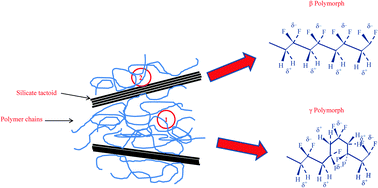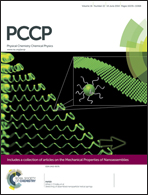A new approach for mechanisms of ferroelectric crystalline phase formation in PVDF nanocomposites
Abstract
This paper proposes a new mechanism for ferroelectric polymorph formation of poly(vinylidene fluoride) (PVDF) nanocomposites. Utilizing time-resolved Fourier transform infrared spectroscopy (FTIR), the real-time investigation of the conformational changes of the PVDF chain segment during crystallization of neat PVDF and the corresponding nanocomposite was performed. Whilst PVDF–clay nanocomposites exhibited mainly the β crystal phase coexisting with the γ phase at low Tc (Tc < 155 °C), the coexistence of γ and β crystalline phases was found at a high Tc temperature range (Tc > 155 °C). Experimental results were compared with predictions of the Lauritzen and Hoffman (LH) model and discrepancies were observed between model predictions and experiments. We then recalled the Brochard-de Gennes (BD) model and proposed that different crystalline polymorph formation should be inferred as a transition in the reeling-in rate dependence of the friction coefficient on nanocomposites rather than as a change in the relative rates of secondary nucleation and substrate completion. Combining LH and BD models we proposed a new mechanism to answer the contradictory questions associated with nanocomposite polymorphism. The coexistence of different polymorphs in nanocomposites was proposed to be associated with the coexistence of fast and slow moving chains, which were recognized as the free and adsorbed chains by nanofillers.


 Please wait while we load your content...
Please wait while we load your content...